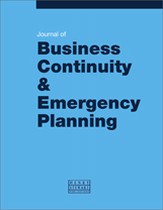Collective response to public health emergencies and large-scale disasters: Putting hospitals at the core of community resilience
Abstract
Healthcare organisations are a critical part of a community’s resilience and play a prominent role as the backbone of medical response to natural and manmade disasters. The importance of healthcare organisations, in particular hospitals, to remain operational extends beyond the necessity to sustain uninterrupted medical services for the community, in the aftermath of a large-scale disaster. Hospitals are viewed as safe havens where affected individuals go for shelter, food, water and psychosocial assistance, as well as to obtain information about missing family members or learn of impending dangers related to the incident. The ability of hospitals to respond effectively to high-consequence incidents producing a massive arrival of patients that disrupt daily operations requires surge capacity and capability. The activation of hospital emergency support functions provides an approach by which hospitals manage a short-term shortfall of hospital personnel through the reallocation of hospital employees, thereby obviating the reliance on external qualified volunteers for surge capacity and capability. Recent revisions to the Joint Commission’s hospital emergency preparedness standard have impelled healthcare facilities to participate actively in community-wide planning, rather than confining planning exclusively to a single healthcare facility, in order to harmonise disaster management strategies and effectively coordinate the allocation of community resources and expertise across all local response agencies.
The full article is available to subscribers to the journal.
Author's Biography
James L. Paturas is Director of the Yale New Haven Center for Emergency Preparedness and Disaster Response (YNH-CEPDR). He also serves as Director of the World Health Organization/Pan American Health Organization Collaborating Center for Emergency Preparedness and Disaster Response and the Connecticut Center of Excellence for Bioterrorism Preparedness and Response at Yale New Haven Health System. Mr Paturas received his master’s in public administration, with a concentration on organisational leadership, from Norwich University and is an alumnus of the Harvard Kennedy School of Government, Executive Leadership Education Program.
Stewart Smith CDR, MSC, USN (Ret.) is Vice President for Logistics Support Incorporated’s Health Services Support (Emergency Preparedness and Response) Division. A recently retired Navy Commander, Medical Service Corps Officer, Mr Smith’s military history spans over 25 years of progressive assignments that include Chief of the Joint Regional Medical Plans and Operations Division for the North American Aerospace Defense Command and the US Northern Command, Surgeons Directorate; Director of International Health Operations Policy, Homeland Defense, and Contingency Planning Policy for the Assistant Secretary of Defense for Health Affairs; Branch Chief for the Joint Staff, Health Services Support Division; and Branch Head for the Deployable Medical Systems, Office of the Chief of Naval Operations, Medical Plans and Policy. He is the co-founder, current President and a Fellow of the American College of Contingency Planners.
Joseph Albanese received his PhD from McGill University, Department of Medicine, in 1998. Currently, Dr. Albanese serves as the Radiation Biodosimetrist for the Yale New Haven Health System Center for Emergency Preparedness and Disaster Response (YNHHS-CEPDR) and the State of Connecticut. Joseph is an experienced research investigator who holds an appointment at Yale University School of Medicine, Department of Therapeutic Radiology.
Citation
Paturas, James L., Smith, Deborah, Smith, Stewart and Albanese, Joseph (2010, July 1). Collective response to public health emergencies and large-scale disasters: Putting hospitals at the core of community resilience. In the Journal of Business Continuity & Emergency Planning, Volume 4, Issue 3. https://doi.org/10.69554/CLFB2880.Publications LLP
